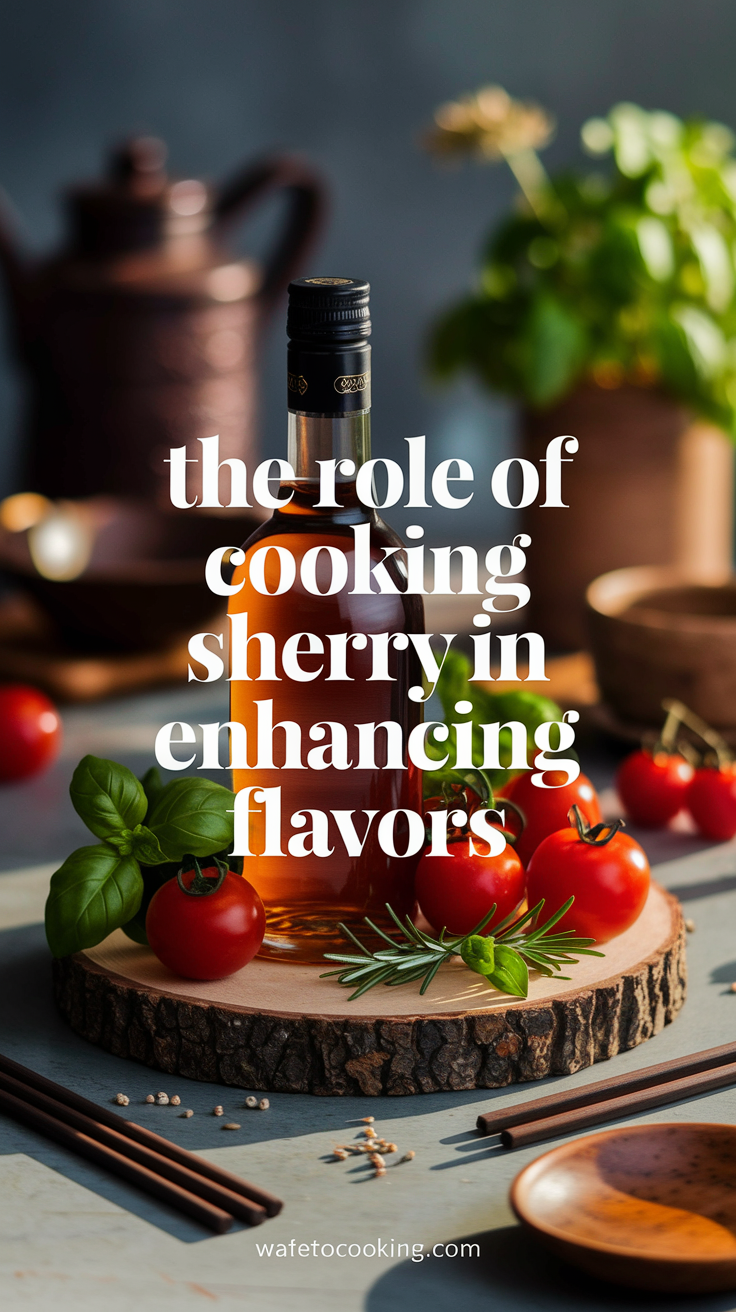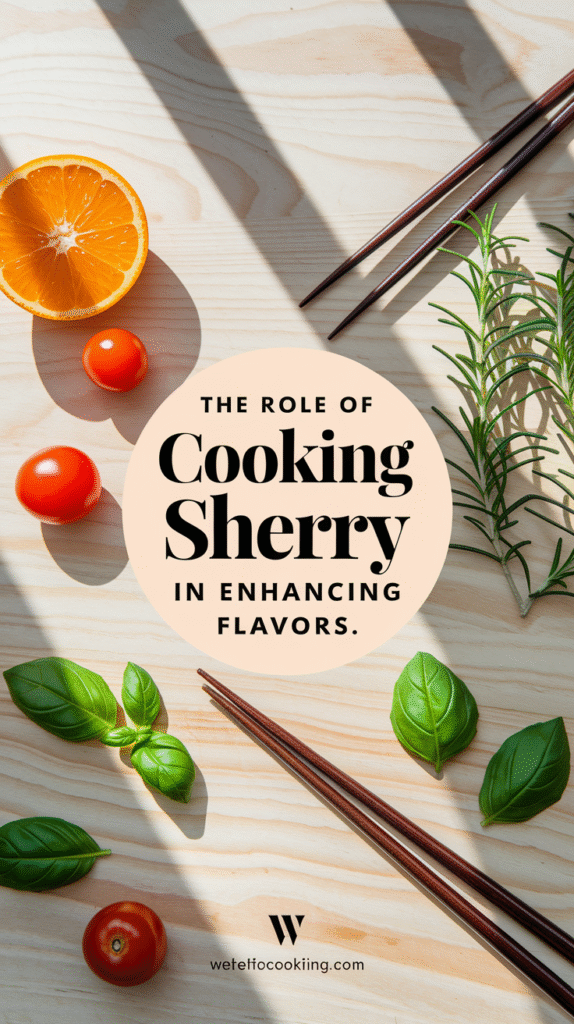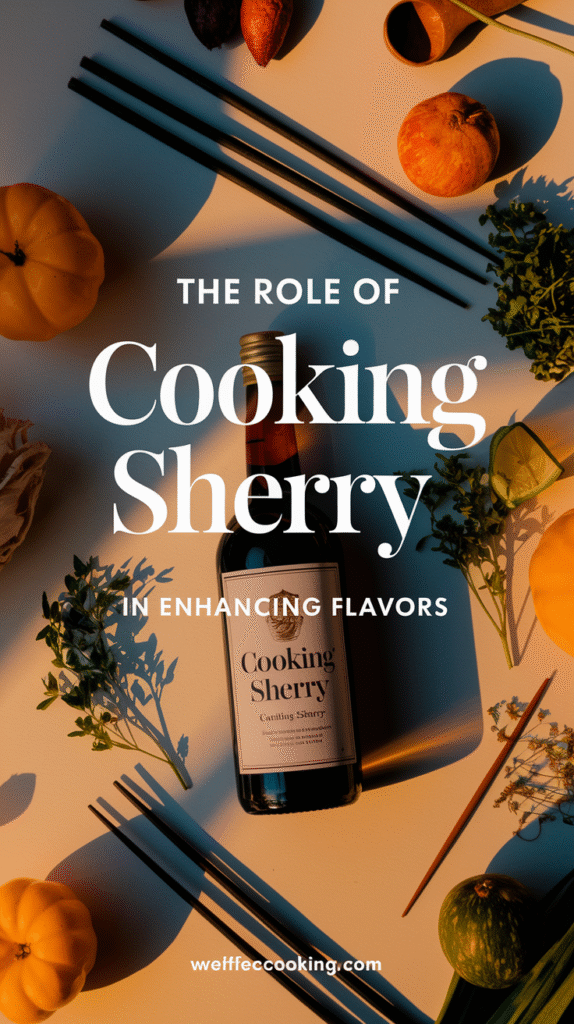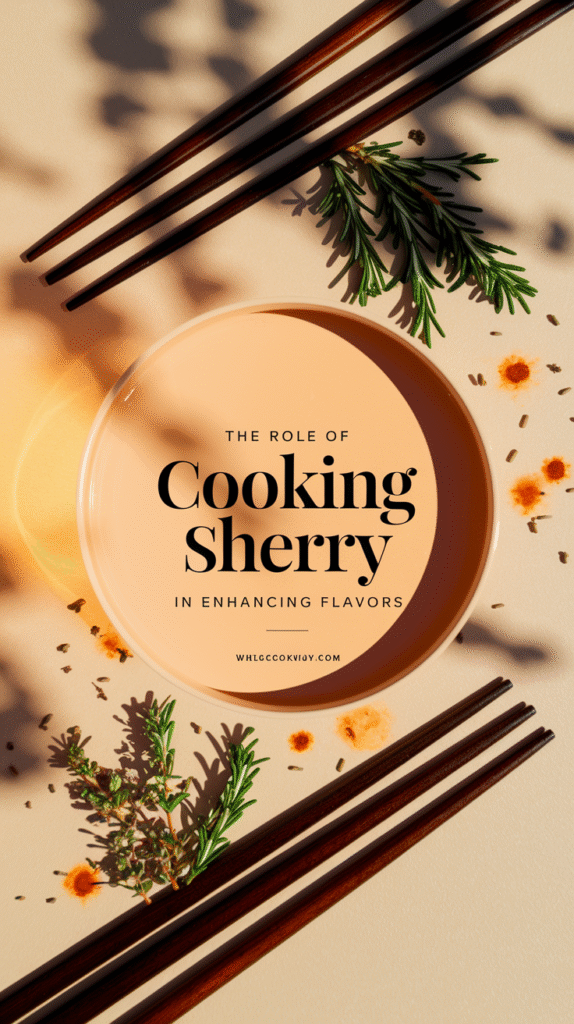Cooking sherry plays a crucial role in the culinary world, offering both depth and complexity to a variety of dishes. This fortified wine has a unique flavor profile that enriches meals, making it a staple ingredient in many kitchens. Understanding how to use cooking sherry can significantly enhance your cooking, bringing out flavors you didn’t know you could achieve.
Cooking sherry is not just any ordinary wine; it is specifically made for cooking. Unlike regular drinking sherry, which is often higher quality and intended for sipping, cooking sherry is fortified with salt and has a longer shelf life, making it a convenient option for home cooks. Here are some of the ways cooking sherry can enhance your dishes:
1. Flavor Enhancement
One of the primary benefits of using cooking sherry is its ability to enhance flavors. The rich, nutty notes of sherry can complement a variety of ingredients, such as:
- Meats: Cooking sherry works exceptionally well with meats like chicken, pork, and beef, adding a savory depth.
- Vegetables: A splash of sherry can elevate sautéed or roasted vegetables, making the dish more flavorful.
- Soups and Sauces: It acts as a wonderful agent in sauces, adding a unique taste that makes your dishes stand out.
2. Creating Complex Flavors
Cooking sherry can help create layers of flavor in your meals. For example, when deglazing a pan after searing meat, adding cooking sherry can lift those tasty brown bits off the bottom, leading to a rich sauce packed with flavor. The sweetness and acidity help balance the dish, making it more appealing to the palate.
3. Tenderizing Properties
Another advantage of cooking sherry is its ability to tenderize meat. The acidity in sherry can break down proteins, resulting in tender meat. This is especially beneficial in marinades where you want to ensure your proteins are juicy and full of flavor. Consider a simple marinade using:
- 2 tablespoons of cooking sherry
- 1 tablespoon of soy sauce
- 1 teaspoon of garlic powder
This mixture will not only flavor the meat but also help it remain moist during cooking.
4. Culinary Versatility
Cooking sherry is incredibly versatile and can be used in various dishes. It’s perfect for:
- Stir-Fries: A splash can add a hint of sweetness and acidity to your stir-fries.
- Risottos: Adding cooking sherry in the cooking liquid can introduce a complex flavor, enhancing the overall dish.
- Dressings: Incorporate sherry into dressings for salads or marinades, giving a gourmet touch to your everyday meals.
5. Storage and Usage Tips
While cooking sherry is shelf-stable, proper storage will ensure it retains its quality. Here are some key points:
- Store open bottles in a cool, dark place to prevent spoilage.
- Use within a few months for the best flavor.
- If your recipe calls for a certain amount, consider using the same amount in your cooking to avoid excessive seasoning from the salt content.
In wines, tasting notes are essential to evaluate quality. Here’s a simple comparison table to help you choose cooking sherry:
| Type | Tasting Notes | Best Uses |
|---|---|---|
| Dry Sherry | Nutty, Briny, and Crisp | Meat dishes, Sauces |
| Sweet Sherry | Caramel, Fig, and Honey | Desserts, Marinades |
| Medium Dry Sherry | Balanced with a touch of sweetness | Vegetable dishes, Risottos |
With cooking sherry, the possibilities are endless. If you’re looking to enhance your culinary creations, don’t hesitate to experiment with this unique ingredient. To learn more about cooking sherry and other culinary tips, you can visit websites like Food Network and Serious Eats. These resources can provide inspiration and delicious recipes to try.
Cooking sherry into your meals not only brings a delightful twist but also showcases your culinary skills. So, the next time you’re in the kitchen, reach for that bottle of cooking sherry and let your dishes shine!
Cooking Sherry vs. Regular Wine: Key Differences
Cooking sherry and regular wine may seem similar at first glance, but they have distinct differences that can greatly affect your cooking and dining experiences. Understanding these differences is essential, especially if you’re looking to elevate your culinary skills. Let’s dig into what sets cooking sherry apart from regular wine, ensuring you make informed choices in the kitchen.
What is Cooking Sherry?
Cooking sherry is a fortified wine made specifically for culinary purposes. It has a higher alcohol content than regular wine, typically around 17% or more. The fortification process involves adding distilled spirits, which helps preserve the wine and enhances its flavor profile. Cooking sherry often comes with added salt, which makes it unsuitable for drinking but ideal for cooking. The salt acts as a preservative, allowing it to have a longer shelf life without refrigeration.
What is Regular Wine?
Regular wine, also known as table wine, is intended for drinking and can range in alcohol content from about 8% to 15%. Unlike cooking sherry, it is not typically fortified, which means it doesn’t have the added shelf life or flavor concentration that comes with that process. Regular wines are available in a variety of types, such as red, white, rosé, and sparkling, each with unique flavor profiles based on the grape variety and fermentation methods. If you want a wine to sip and enjoy with your meal, regular wine is the way to go.
Key Differences Between Cooking Sherry and Regular Wine
| Feature | Cooking Sherry | Regular Wine |
|---|---|---|
| Alcohol Content | 17% or more | 8% to 15% |
| Purpose | Cooking | Drinking |
| Fortification | Yes | No |
| Salt Content | Usually added | None |
| Shelf Life | Longer due to salt and fortification | Shorter, especially once opened |
Flavor Profiles
The flavor differences between cooking sherry and regular wine are significant. Cooking sherry often has rich, nutty, and slightly sweet undertones, which can add depth to dishes like sauces, marinades, and soups. On the other hand, regular wine varies widely in taste depending on the grape and region. For instance, a Cabernet Sauvignon will have bold and fruity notes, while a Chardonnay may be creamy and buttery. Choosing the right type of wine for cooking is crucial to achieving the desired flavor in your dishes.
When to Use Cooking Sherry
Cooking sherry is a fantastic addition to various dishes. You might want to reach for it when making:
- Sauces, particularly cream-based or gravy sauces
- Marinades for meats, enhancing their flavor
- Soups and stews that require a depth of flavor
- Seafood dishes, which often benefit from the nutty notes
However, avoid using cooking sherry in dishes where wine is served alongside the meal, as the added salt could spoil the pairing.
When to Use Regular Wine
Regular wine shines in various culinary scenarios as well. Use it when you want to:
- Pair it directly with your meal for an enjoyable drinking experience
- De-glaze pans after sautéing, adding a layer of flavor
- Make lighter sauces or dressings that complement rather than overpower
Health Considerations
When choosing between cooking sherry and regular wine, it’s also essential to consider health factors. Cooking sherry’s high sodium content may not be suitable for individuals on restricted diets, while regular wine, when consumed moderately, can offer some health benefits, such as antioxidants for heart health.
Understanding these differences will help you make the best choice for your cooking needs. Whether you choose cooking sherry for its robust flavor or a regular wine for your palate, knowing what each brings to the table can take your culinary creations to the next level. For more guidance on enhancing your cooking with wine, visit Wine Enthusiast and Food & Wine.
Creative Recipes Featuring Cooking Sherry
Cooking sherry is a versatile ingredient that can elevate your dishes with its rich flavor profile. It’s not just a cooking staple; it’s an essential element that can help you create delightful meals from scratch. Let’s explore some creative recipes featuring cooking sherry that you can easily prepare at home.
Savory Dishes
Sherried Mushroom Risotto
This creamy risotto is perfect for a cozy dinner. The cooking sherry adds depth to the flavor, making it rich and aromatic.
- Ingredients:
- 1 cup Arborio rice
- 1/2 cup cooking sherry
- 4 cups chicken or vegetable broth
- 1 cup chopped mushrooms
- 1 small onion, finely chopped
- 2 tablespoons olive oil
- 1/2 cup Parmesan cheese
- Salt and pepper to taste
- Instructions:
- Heat the olive oil in a pan and sauté the onions until translucent.
- Add the mushrooms and cook for about 5 minutes.
- Stir in the rice and toast for 2 minutes.
- Pour in the cooking sherry and let it evaporate.
- Gradually add the broth, one ladle at a time, stirring until absorbed.
- Add the Parmesan cheese, and season with salt and pepper. Serve warm.
Chicken in Sherry Sauce
This dish combines succulent chicken with a fragrant sauce that includes cooking sherry, giving it an elegant touch.
- Ingredients:
- 4 chicken breast halves
- 1/2 cup cooking sherry
- 1 cup chicken broth
- 2 tablespoons butter
- 1 clove garlic, minced
- 1 teaspoon thyme
- Salt and pepper to taste
- Instructions:
- Season the chicken with salt and pepper. In a pan, melt the butter over medium heat.
- Cook the chicken until golden brown, about 5 minutes per side. Remove from the pan.
- Add the garlic and cook for another minute before adding the cooking sherry.
- Stir in the chicken broth and thyme, then return the chicken to the pan.
- Simmer until the chicken is cooked through. Serve with your favorite sides.
Flavorful Sauces and Marinades
Sherry Garlic Marinade
This marinade is perfect for meats or vegetables, infusing them with a savory flavor that enhances any dish.
- Ingredients:
- 1/4 cup cooking sherry
- 2 tablespoons soy sauce
- 3 cloves garlic, minced
- 1 teaspoon ginger, grated
- 1 tablespoon olive oil
- Instructions:
- Whisk together all ingredients in a bowl.
- Place your choice of meat or vegetables in a zip-lock bag and pour in the marinade.
- Seal and refrigerate for at least an hour before grilling or roasting.
Cooking Sherry Pan Sauce
This quick pan sauce can transform any meal into a gourmet experience.
- Ingredients:
- 1/2 cup cooking sherry
- 1 cup chicken stock
- 1 tablespoon Dijon mustard
- Salt and pepper to taste
- Instructions:
- After cooking your protein, deglaze the pan with cooking sherry over medium heat.
- Scrape the browned bits from the bottom of the pan.
- Add the chicken stock and mustard, then reduce the sauce until thickened. Season to taste.
Sweet Treats
Sherry-infused Fruit Salad
Add a unique touch to your dessert with this refreshing fruit salad.
- Ingredients:
- 2 cups mixed fruit (such as berries, melons, and citrus)
- 1/4 cup cooking sherry
- 1 tablespoon honey
- Instructions:
- In a bowl, combine the fruit, cooking sherry, and honey.
- Toss gently to coat, then let it chill for 30 minutes before serving.
These creative recipes featuring cooking sherry are not only delicious but also easy to prepare. Whether you’re making risotto, marinating meats, or concocting a refreshing dessert, cooking sherry can truly enhance your culinary creations. For more inspiration and details on cooking with sherry, visit Cooking Light or check out Simply Recipes.
Substitutes for Cooking Sherry: What You Need to Know
Cooking sherry is a fortified wine used in various dishes to enhance flavor and add depth. However, there may be times when you find yourself without it in your pantry. Fortunately, several substitutes can step in without compromising your dish’s quality. Here are some excellent options to consider.
1. White Wine
White wine is perhaps the closest alternative to cooking sherry. When using white wine, aim for a dry variety without too much sweetness. The acidity in white wine can mimic the tanginess of cooking sherry. Use a 1:1 ratio when substituting. Drinking quality wines are usually better for cooking, so choose a bottle you might enjoy sipping on.
2. Apple Cider Vinegar
Apple cider vinegar offers a sweet and tangy flavor ideal for many recipes that call for cooking sherry. It can bring a bright, fruity zest to stews, sauces, and marinades. Use it sparingly, as it can be more acidic. A common substitution ratio is 1 tablespoon of apple cider vinegar for each tablespoon of cooking sherry, adjusted according to taste.
3. White Wine Vinegar
If you have white wine vinegar on hand, it can serve as another great substitute. It has a brightness that closely resembles cooking sherry, making it suitable for marinades and dressings. Use a 1:1 ratio, but keep in mind that it’s more acidic. A small amount can cleanly bring forward the flavors of the dish.
4. Rice Vinegar
Rice vinegar is a mild and slightly sweet option that can replace cooking sherry, especially in Asian dishes. This substitute works well in stir-fries or marinades where the sweetness balances the overall flavor. Use it in a 1:1 ratio, noting your preference for sweetness as necessary.
5. Low-Sodium Chicken Broth
If you’re looking for a non-alcoholic substitute, low-sodium chicken broth can work. While it doesn’t mimic the flavor profile of cooking sherry, it provides a rich base that can enhance your dish. You can mix low-sodium chicken broth with a splash of vinegar or lemon juice for added acidity. A good starting point is to use 1/2 cup of broth with a teaspoon of vinegar or lemon juice in place of each cup of sherry.
6. Grape Juice
For a non-alcoholic, sweet option, grape juice can serve reasonably well as a substitute for cooking sherry. It brings a fruity flavor but lacks the acidity. To better mimic cooking sherry, dilute grape juice with a little vinegar. Use 1 cup of grape juice mixed with 1 tablespoon of white vinegar to enhance its versatility in cooking.
7. Homemade Cooking Sherry Substitute
If you’re feeling adventurous, you can make your own cooking sherry substitute with ingredients you have at home. Combine the following:
- 1 cup of grape juice
- 1 tablespoon of white wine vinegar or apple cider vinegar
Mixing these can help you adjust the flavor profile closer to that of cooking sherry.
8. Read Labels on Store-Bought Substitutes
If you opt for store-bought substitutes, read the labels carefully. Many culinary products labeled “cooking sherry” contain salt or other additives, which may not provide the flavor kick you’re seeking. Look for quality products without unnecessary ingredients.
Using Substitutes Effectively
When replacing cooking sherry with these alternatives, consider the role of sherry in your dish. Is it for flavor, to deglaze a pan, or to add moisture? This understanding will help you choose the most effective substitute. Adjust the seasoning of your dish since some substitutes may contain salt or additives that could alter the final taste.
These substitutes for cooking sherry not only work but also offer a range of flavors that can complement your meals beautifully. Whether you choose white wine, vinegar, or a homemade blend, you can keep your dishes delicious and savory without missing out on that cooking sherry flavor. For more insights into cooking substitutions, you can check out Serious Eats or Food Network.
The Health Considerations of Using Cooking Sherry in Your Dishes
Cooking sherry is a common ingredient in many households, adding depth and flavor to a variety of dishes. However, before incorporating it into your meals, understanding its health implications is essential. Here, we’ll explore some of the health considerations associated with using cooking sherry in your culinary creations.
Understanding Cooking Sherry
Cooking sherry is a fortified wine, which means it has had extra alcohol and sometimes additional flavors added to it. Unlike regular sherry, which is enjoyed as a beverage, cooking sherry is typically less expensive and contains salt. This makes cooking sherry suitable for enhancing flavors in dishes rather than for sipping. However, the health aspects are important for those mindful of their sodium intake and alcohol consumption.
Alcohol Content
One of the primary concerns with cooking sherry is its alcohol content. Even though most of the alcohol cooks off during the preparation process, some may remain in the final dish, depending on factors like cooking time and temperature. Here are a few things to consider:
- Residual Alcohol: Dishes cooked for long periods reduce alcohol content significantly. However, some recipes that require quick cooking might retain more.
- Cooking Techniques: Methods like flambéing or quick sautéing may leave higher alcohol levels because they don’t allow enough time for evaporation.
Sodium Levels
Many brands of cooking sherry contain added salt, which can be a concern for your health, especially for individuals with high blood pressure or kidney problems. Here’s what you should know:
- High Sodium: Depending on the brand, cooking sherry can contain anywhere from 300 to 600 mg of sodium per tablespoon.
- Alternatives: If you need a low-sodium option, consider using unsalted broth or homemade stock combined with a splash of vinegar to mimic the tangy flavor of sherry.
Health Effects of Cooking Sherry
While cooking sherry can add flavor to dishes, excessive consumption can lead to potential health risks. Here’s a rundown of the most significant effects:
| Health Effect | Description |
|---|---|
| Weight Gain | Higher calorie content from alcohol can contribute to weight gain if used excessively. |
| Increased Blood Pressure | High sodium levels may raise blood pressure, posing risks for heart disease. |
| Addiction | Better awareness is needed for those with a history of alcohol dependency, even in cooking applications. |
Moderation is Key
As with many ingredients, moderation is crucial when using cooking sherry. A small amount can enhance flavor, but it’s best to limit its use, especially if you have specific health concerns. Here are tips for enjoying sherry safely in your meals:
- Measure Accurately: Use precise measurements to keep portion sizes in check.
- Pair Wisely: Combine cooking sherry with fresh herbs and spices to minimize the need for additional salt and calories.
- Substitutions: Experiment with different ingredients, such as white wine vinegar or even fruit juices, for similar flavors without the health concerns.
Ultimately, cooking sherry can be a fantastic way to elevate your dishes, but being mindful of its health considerations is important. To learn more about cooking sherry and healthy alternatives, explore the following resources:
The Kitchn’s Guide on Cooking Sherry
Healthline – Health Considerations
Your culinary journey can be flavorful and health-conscious simultaneously. By understanding the effects of cooking sherry, you can enjoy its benefits while making informed decisions about your health.
Conclusion
Cooking sherry is not just a versatile ingredient; it serves as a flavor booster that can elevate your dishes to new culinary heights. Its unique profile sets it apart from regular wine, making it a favorite among home cooks and professional chefs alike. By understanding these key differences, you can make more informed choices about when and how to use it in your cooking.
Exploring creative recipes that feature cooking sherry opens a world of opportunities. Whether you’re making a rich mushroom sauce, a savory stir-fry, or a delicious seafood dish, adding cooking sherry can enhance the flavors significantly. If you find yourself without cooking sherry on hand, knowing suitable substitutes can save the day. Options like white wine or even vinegar can often mimic its flavor but remember, the final taste may vary.
While cooking sherry offers many culinary benefits, it’s also essential to consider health aspects. Since many cooking sherries contain added salts and preservatives, it’s good to be mindful of how much you consume. However, you can still enjoy its flavor with moderation, allowing you to create delightful meals without compromising your health.
Cooking sherry is more than just a pantry staple; it’s a flavorful ally that makes cooking enjoyable and rewarding. So the next time you reach for that bottle, remember how it can transform your dishes and spark your creativity in the kitchen. Embrace the culinary magic of cooking sherry, and enjoy experimenting with it in all your favorite recipes!







Leave a Reply